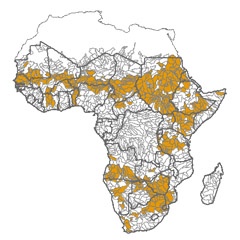The theme of World Water Week 2013 (September 1-6) is “Water Cooperation: Building Partnerships.” Today, we highlight key research that looks at investment strategies for overcoming physical and economic limitations to water security.
In Africa south of the Sahara, where agriculture is predominantly rainfed, farmers’ access to water is limited based on time (during droughts and dry seasons) and space (in arid areas). But water scarcity in the region is not necessarily caused by a physical lack of water. In fact, much of the region is generally considered to suffer from what’s called “economic water scarcity,” which means that investments in water resources and relevant human capacity are not substantial enough to meet water demands in an area where the population does not have the financial means to make use of an adequate water source on its own.
In the forthcoming Agricultural Water Management article “Estimating the Potential for Expanding Smallholder Irrigation in Sub-Saharan Africa,” IFPRI authors Hua Xie, Liangzhi You, Benjamin Wielgosz, and Claudia Ringler analyze the costs and benefits of potentially expanding four different irrigation technologies (motor pumps, treadle pumps, communal river diversion, and small reservoirs) in the region. They developed an integrated technique that combines GIS data analysis with predictive hydrologic and economic modeling tools, which allowed for in-depth analysis of how each of the smallholder irrigation methods would affect both farmers and the environment.
The authors found that smallholder irrigation can be profitably developed across much of Africa south of the Sahara in the coming decades. Most notably, motor pumps have the potential to expand the amount of agricultural land irrigated during the dry season to 30 million hectares—four times the current area. While this could significantly change smallholder farming in the region, the authors’ other major finding—that, despite popular belief, many areas do suffer from actual physical water scarcity—presents a major setback. According to their analysis, basins primarily located in areas with arid, semi-arid, and dry sub-humid climates are lacking sufficient water to meet demands and will not be able to fully implement small-scale dry-season expansion.
Basins in these areas (including much of the Sahel stretching from West to East Africa and a belt of land stretching from Angola to northern Botswana and Zimbabwe, reaching into southern Mozambique and northern South Africa) are also more likely to be exposed to adverse environmental risks resulting from irrigation expansion. Since environmental flow rules implemented in the authors’ modeling are seldom legislated or enforced in reality, the sustainability of aquatic environments would likely be undermined. In the case of irrigation pumps (both motor and treadle), which rely heavily on groundwater, the environmental risks include overdraft of existing water resources. Thus, incentives, regulations, and monitoring systems that minimize this unintended consequence of small-scale irrigation expansion must go hand-in-hand with investments in these areas. These and other irrigation investment strategies will be discussed during World Water Week 2013 in Stockholm at the “Bridging Land-Water-Ecosystem Divides” workshop on Tuesday, September 3.







